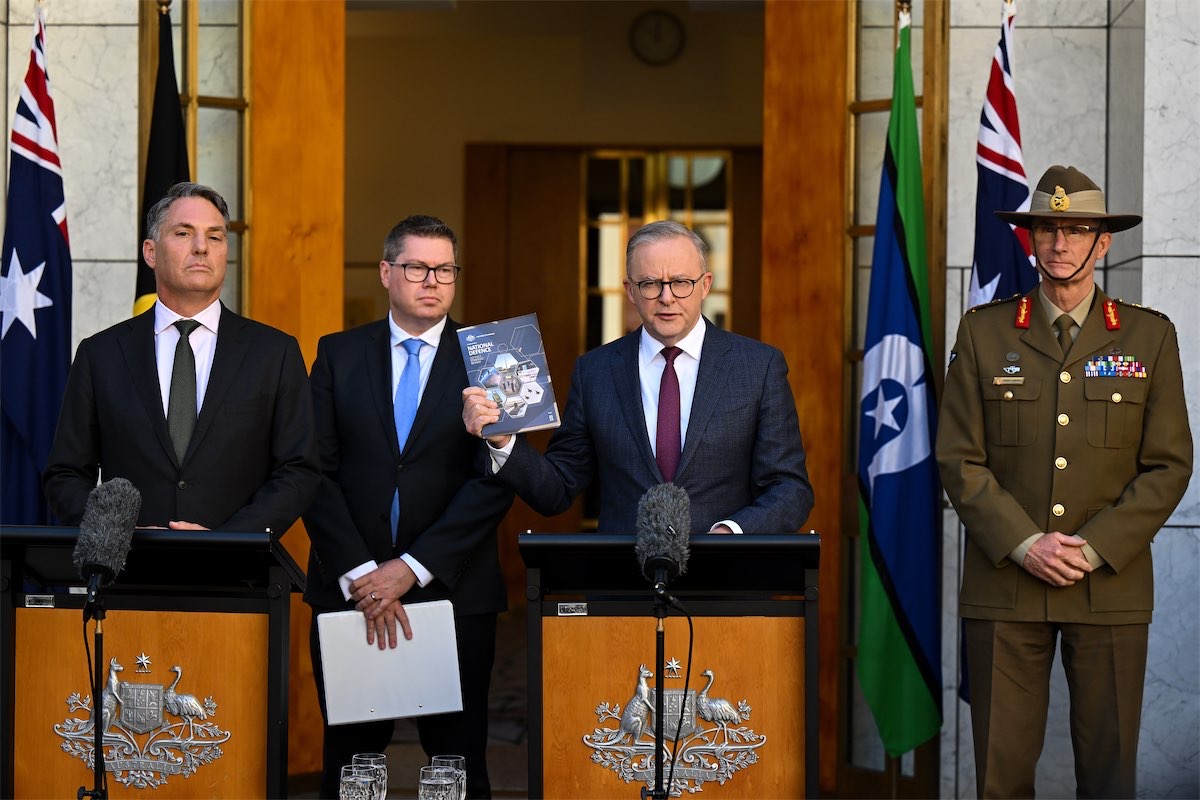
‘The risks of military escalation or miscalculation are rising’, according to the long-awaited defence review. The ANU’s JOHN BLAXLAND, looks at what the review says and what it means for Australia.
THE Albanese government this week released a declassified version of the much-anticipated defence strategic review, authored by former defence chief Angus Houston and former defence minister Stephen Smith.
The report looks at Australia’s defence equipment and resourcing, but it also looks beyond just acquisitions.
So what’s in the report? What were some of the political drivers of the decisions taken, and what does it tell us about Australian defence strategy in the mid-2020s?
Increasing risks
The review builds on the Defence Strategic Update of 2020, which stressed the time we’d have to prepare for a potential conflict is reducing.
It highlights a shift from describing the defence of Australia in narrow, conventional military terms to a broader approach that requires a “whole-of-nation effort”.
It describes Australia’s strategic environment in the Indo-Pacific as one that faces increasing competition that operates on multiple levels – economic, military, strategic and diplomatic – all interwoven and all framed by an intense contest of values and narratives.
A large-scale conventional and non-conventional military build-up without strategic reassurance is contributing to the most challenging circumstances in our region for decades.
It adds that “the risks of military escalation or miscalculation are rising”.
It mentions that climate change complicates our challenges further. It also notes that “economic coercion” and “other actions that fall short of kinetic conflict” are impinging upon the ability of “countries to exercise their own agency and decide their own destinies”.
In response, the paper declares “we must sharpen our focus on what our interests are, and how to uphold them”. It focuses on the need for Australia to develop long-range strike capabilities, notably with longer-range missiles (it says we’re in the “missile age”) and advanced nuclear-powered submarines.
The ADF has long focused on maintaining a “balanced force” for three concentric circles: defending the continent, regional engagement, and contributions further afield as a “good global citizen”.
But the focus in this review shifts. It emphasises what it calls a “focused force”, with five tasks:
- defence of the nation
- deterrence through denial (that is, deterring adversaries by reducing any possible benefits of engaging in an attack)
- protection of economic connections
- working with regional partners
- and supporting the so-called rules based global order.
Four of these five tasks involve acting well beyond Australia’s shores. That’s a significant shift.
Six priorities going forward
The report lists six priorities, and 62 recommendations, for defence acquisitions.
The first priority is acquiring nuclear-powered submarines, of which Australia already has a plan following the AUKUS announcement in March. The government recognises conventional diesel-electric submarines are now vulnerable to detection, due to advances in surveillance. Nuclear-powered subs are less likely to be spotted as they don’t have to come up for a “snort” to refuel.
Second is improving our precision strike capability. Guided weapons and explosives are in short supply, in part thanks to the war in Ukraine, but also because we’ve tended not to develop large stockpiles. The government also plans to invest in developing the ability to manufacture advanced munitions onshore, especially long-range guided weapons. Officials privately advise that they expect we will produce licensed versions of United States’-sourced weapons systems to equip the ADF.
The third priority is about supporting the second pillar of the AUKUS (the first pillar is the submarines). This focuses on acceleration of technology such as artificial intelligence, hypersonics, and longer-range precision guided munitions.
Fourth is the redevelopment of Australia’s northern bases, from Cocos (Keeling) Islands ranging to the air bases and other defence infrastructure across northern Australia.
Fifth is investment in recruitment and retention of ADF personnel. The previous federal government projected a nearly 20,000 increase in uniformed defence personnel. The current government committed to follow through on that, with an increase of 5% per year, but there was little to show for any further surge.
Sixth is an emphasis on improving relations with the region, with a particular focus on Pacific Island nations.
Significant adjustments
The review does not abandon the army. But it significantly cuts back its planned acquisition of infantry fighting vehicles intended to replace its Vietnam War-era armoured personnel carriers. It reduces the planned acquisition from 450 to 129 vehicles.
What’s more, the review says Australia must cancel the planned acquisition of addition mobile (or “self-propelled”) artillery. It advocates for weapons with a longer range instead, such as “HIMARS” (high mobility artillery rocket systems), which is currently being used by Ukrainian forces on the battlefield.
So the army will need to make some significant adjustments.
The report also calls for a review into the navy surface combat fleet. Australia has been planning to construct 12 offshore patrol vessels and nine Hunter-class frigates for the coming years, but there’s expectations both numbers will be rejigged. The challenge is to get this smaller naval review done quickly. Australia’s naval shipbuilding capability atrophies quickly if left dormant and delays have already seen the naval shipbuilding industry under stress.
The thinking now is not just about air, land and sea forces, but also cyber and space. The report emphasises a robust cyber capability. The Australian Signals Directorate’s cyber program, called REDSPICE, is part of the mix.
The review is largely internally coherent, but there’s a dissonance between the rhetoric and the substance – noting the absence of substantial additional resource allocation. Perhaps this reflects the political headwinds faced by the Albanese government.
With the left wing of the ALP spooked by former Prime Minister Paul Keating’s aggressive teardown of AUKUS and defence policy writ large, coupled with calls for great expenditure on health, education and welfare, the government is reluctant to spell out how the increases in budget forecast in the review will come to fruition.
But it seems clear the Albanese cabinet has an acute appreciation of the security challenges butting up against the mood of a more sanguine political base.![]()
John Blaxland, Professor, Strategic and Defence Studies Centre, Australian National University. This article is republished from The Conversation.
Who can be trusted?
In a world of spin and confusion, there’s never been a more important time to support independent journalism in Canberra.
If you trust our work online and want to enforce the power of independent voices, I invite you to make a small contribution.
Every dollar of support is invested back into our journalism to help keep citynews.com.au strong and free.
Thank you,
Ian Meikle, editor









Leave a Reply